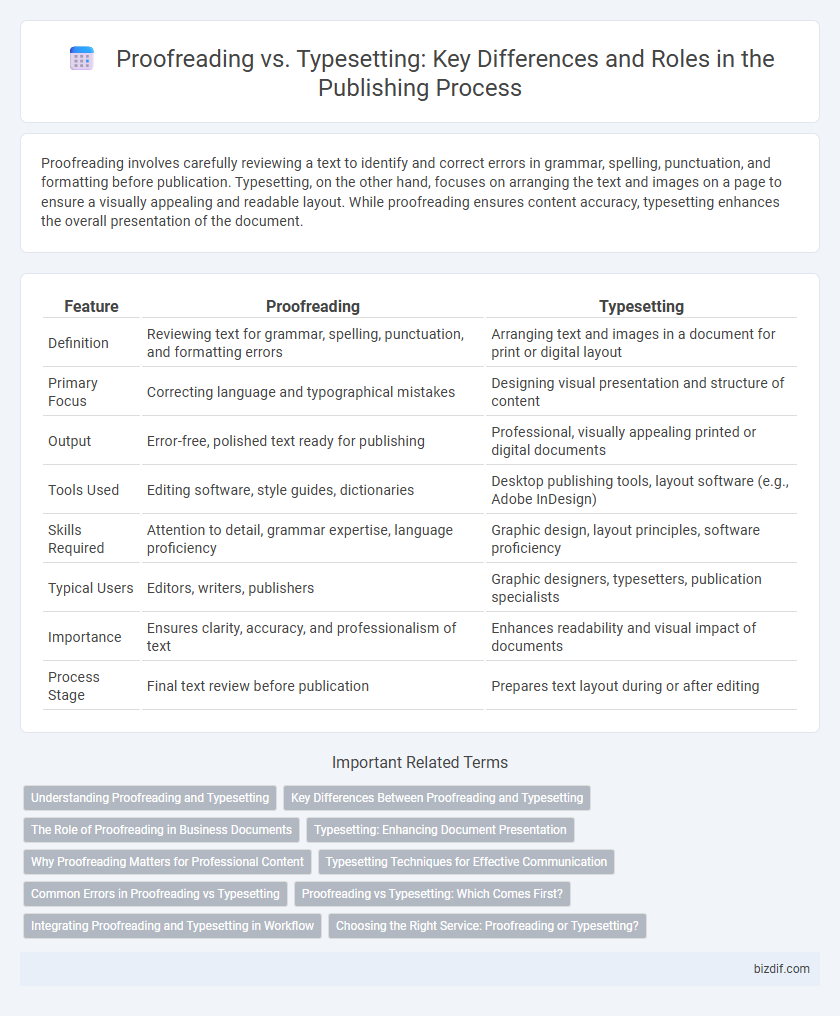Proofreading involves carefully reviewing a text to identify and correct errors in grammar, spelling, punctuation, and formatting before publication. Typesetting, on the other hand, focuses on arranging the text and images on a page to ensure a visually appealing and readable layout. While proofreading ensures content accuracy, typesetting enhances the overall presentation of the document.
Table of Comparison
| Feature | Proofreading | Typesetting |
|---|---|---|
| Definition | Reviewing text for grammar, spelling, punctuation, and formatting errors | Arranging text and images in a document for print or digital layout |
| Primary Focus | Correcting language and typographical mistakes | Designing visual presentation and structure of content |
| Output | Error-free, polished text ready for publishing | Professional, visually appealing printed or digital documents |
| Tools Used | Editing software, style guides, dictionaries | Desktop publishing tools, layout software (e.g., Adobe InDesign) |
| Skills Required | Attention to detail, grammar expertise, language proficiency | Graphic design, layout principles, software proficiency |
| Typical Users | Editors, writers, publishers | Graphic designers, typesetters, publication specialists |
| Importance | Ensures clarity, accuracy, and professionalism of text | Enhances readability and visual impact of documents |
| Process Stage | Final text review before publication | Prepares text layout during or after editing |
Understanding Proofreading and Typesetting
Proofreading involves carefully reviewing a text to identify and correct errors in grammar, spelling, punctuation, and formatting, ensuring accuracy and clarity. Typesetting focuses on arranging text and images on a page, optimizing visual presentation through font selection, spacing, and layout design. Understanding the distinction between proofreading and typesetting is crucial for producing polished, professional documents with both error-free content and aesthetically pleasing formatting.
Key Differences Between Proofreading and Typesetting
Proofreading primarily involves reviewing and correcting text for spelling, grammar, punctuation, and formatting errors to ensure accuracy and readability. Typesetting focuses on arranging text and images on a page according to design specifications, managing fonts, spacing, and layout to create visually appealing documents. Key differences lie in proofreading's emphasis on content accuracy and typesetting's role in visual presentation and document structure.
The Role of Proofreading in Business Documents
Proofreading in business documents ensures accuracy, clarity, and professionalism by identifying and correcting typographical errors, grammatical mistakes, and formatting inconsistencies before final distribution. This process enhances effective communication, reduces the risk of misunderstandings, and upholds the company's credibility. Unlike typesetting, which focuses on the visual arrangement of text, proofreading specifically targets content correctness to maintain document integrity.
Typesetting: Enhancing Document Presentation
Typesetting involves arranging text and images on a page to create an aesthetically pleasing and readable document, which enhances overall presentation quality. It includes font selection, spacing adjustments, and layout design to improve visual appeal and ensure consistency throughout the document. Professional typesetting ensures that documents meet industry standards and improve reader engagement.
Why Proofreading Matters for Professional Content
Proofreading ensures error-free, polished content that enhances credibility and reader trust, which typesetting alone cannot guarantee. It catches grammar, punctuation, and formatting mistakes that impact clarity and professionalism. Accurate proofreading improves content quality, essential for maintaining a strong brand reputation and effective communication.
Typesetting Techniques for Effective Communication
Typesetting techniques play a crucial role in effective communication by organizing text for clarity, readability, and visual appeal. Utilizing consistent fonts, proper line spacing, and balanced margins enhances the reader's experience and ensures the content is accessible across different media. Advanced methods like grid systems and typographic hierarchy guide the eye and emphasize key information, differentiating typesetting from the error-focused process of proofreading.
Common Errors in Proofreading vs Typesetting
Common errors in proofreading include typographical mistakes, grammatical inconsistencies, and punctuation errors, while typesetting errors primarily involve incorrect font usage, spacing issues, and layout misalignments. Proofreading focuses on content accuracy and language correctness, whereas typesetting ensures the visual presentation and formatting align with design standards. Detecting misplaced margins, inconsistent line spacing, and font size discrepancies are typical typesetting challenges that differ from the textual errors addressed during proofreading.
Proofreading vs Typesetting: Which Comes First?
Proofreading and typesetting are integral steps in the publishing process, with typesetting typically preceding proofreading to format text accurately before final review. Proofreading ensures that all typographical errors, formatting inconsistencies, and content inaccuracies introduced during typesetting are identified and corrected. The sequence is crucial, as proofreading after typesetting guarantees that the final layout is error-free and ready for publication.
Integrating Proofreading and Typesetting in Workflow
Integrating proofreading and typesetting in the workflow enhances accuracy and efficiency by allowing real-time corrections during the layout process, minimizing errors before final print. Utilizing collaborative software platforms streamlines communication between proofreaders and typesetters, ensuring consistency in typography, formatting, and content. This seamless integration reduces turnaround time and improves the overall quality of published materials.
Choosing the Right Service: Proofreading or Typesetting?
Choosing the right service depends on your project needs: proofreading focuses on correcting grammar, spelling, and punctuation errors to ensure textual accuracy, while typesetting involves arranging text and images for visually appealing and readable layouts. Proofreading is essential for content clarity and error-free documents, whereas typesetting enhances design aesthetics and formatting consistency. Understanding the difference allows you to select proofreading for language precision or typesetting for professional document presentation.
Proofreading vs Typesetting Infographic

 bizdif.com
bizdif.com